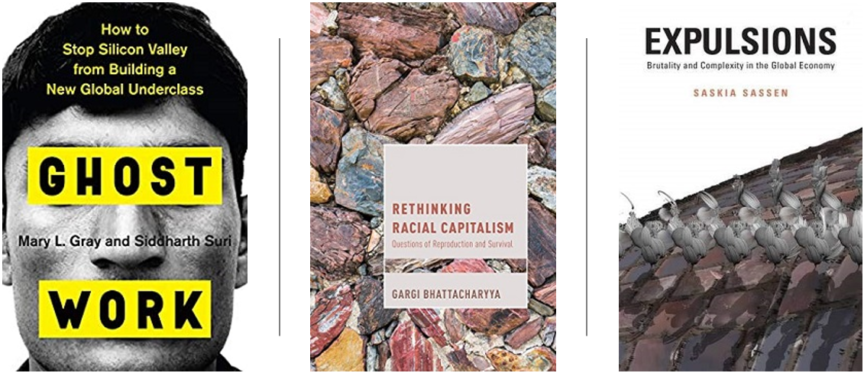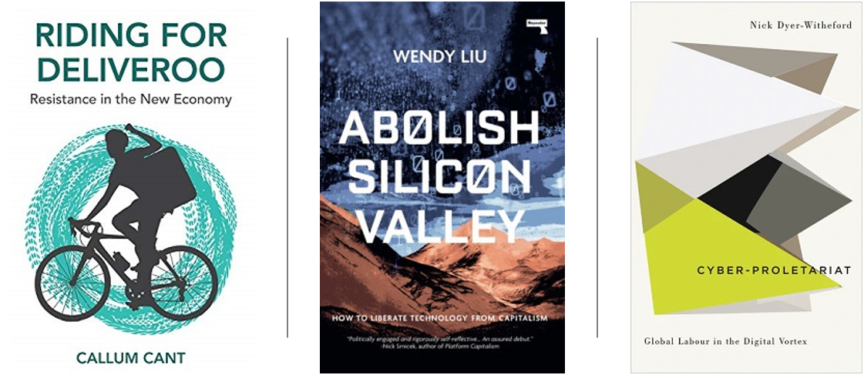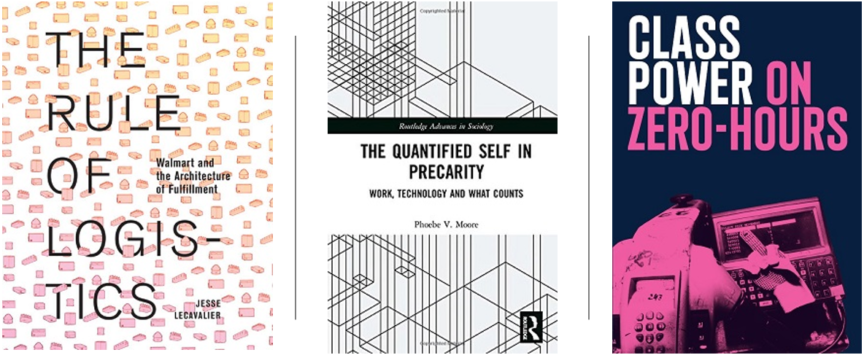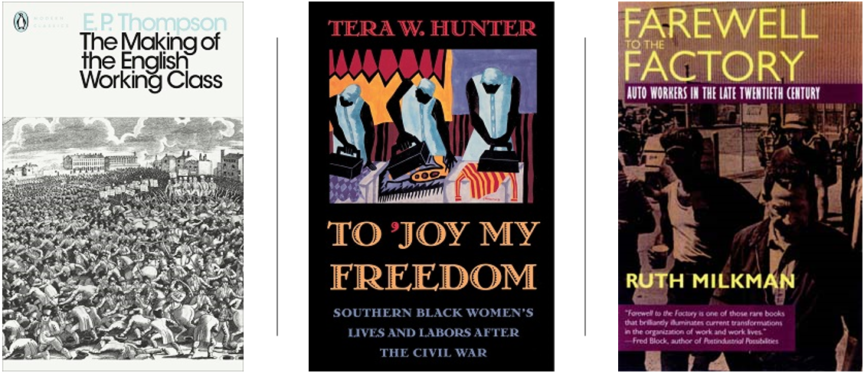12 Books for Understanding the Future of Work
by Sarah Jaffe, Dalia Gebrial, Jamie Woodcock & Craig Gent
28 September 2020

Short of a sudden transition to a post-work paradise or a technological unemployment dystopia, work will continue to structure our lives in some form or another for the foreseeable future. But how best to understand how “where we are” might lead to “what will be”? And how might lessons from the recent and not-so-recent past equip us to deal with the uncertainties the future holds?
To mark our current focus series on the Future of Work, supported by the Rosa Luxemburg Foundation (London Office), we asked some of Novara Media’s friends to share their top recommendations for understanding how our working lives could change in the not-so-distant future.
Dalia Gebrial, contributor to Novara Media and Futures of Socialism.
Popular discussions about the “future of work” often carry utopian visions of a world where work is not done by people. For big business, this means not having to pay to keep their workers alive. For parts of the left, it is a future where technology is harnessed to free people from lives centred around work. Mary L. Gray & Siddharth Suri’s Ghost Work: How to Stop Silicon Valley from Building a New Global Underclass pokes a sobering hole in both – highlighting how the disembodied, “smart” appearance of AI is sustained by a growing body of invisibilised “ghost” workers. Despite carrying the financial, physical and mental burden of making the “new” economy appear frictionless, these workers are underpaid, undervalued and denied basic labour and human rights. Co-written by an anthropologist and computer scientist, this book gives a rich insight into the lives of the labouring underclasses sustaining the online economy.

Gargi Bhattacharyya’s Rethinking Racial Capitalism: Questions of Reproduction and Survival provides the tools to understand how these labouring underclasses – past, present and future – are organised through processes of racialisation, bordering and gendering. Her framework describes how different populations are structurally made reliant upon brutal forms of exploitation. Read alongside Gray & Suri, a picture can be built of how the broader socio-political existences of certain groups makes them ripe for exploitation by Silicon Valley’s model of capitalism. Together, these texts are crucial for keeping a grounded analysis of the relationship between the digital economy and the labouring classes, in what can often be a lofty and speculative field of debate.
Finally, Saskia Sassen’s Expulsions: Brutality and Complexity in the Global Economy explores what it means to be expelled from, or precariously tethered to, wage labour. Indeed, where Gray & Suri emphasise how a brutalised human workforce is integral to the digital economy, Sassen shows how alongside the production of a global working underclass, we also see the creation of surplus populations. Bhattacharyya calls these “edge populations” – people who live at the edge of survival and often in prisons, informal settlements and slums. For all our critiques of wage labour, Sassen reminds us that denial of work is no liberation in this context. As access to full-time, formal employment shrinks and shrinks, Sassen’s book covers some of the brutal and alienating mechanisms used to deal with those who are, for whatever reason, left out. Increased focus on the future of work must also reckon with the future of no-work and the demise of the social state – Sassen’s book provides a sobering and rich framework for understanding this logic, which she calls “expulsion”.
Jamie Woodcock, author of The Gig Economy, Marx at the Arcade and Working the Phones.
Readings on the future of work are often dominated by themes about automation and the end of work. For some, this is something to be warned about, while others celebrate this soon-to-be future. The problem with many of these arguments is that, too often, they are not grounded in any empirical data. There they risk overemphasising technology and forgetting about the central role of workers in the process of work – whether now or the future.

These three books do not make these kinds of claims. Instead, they are a corrective to these broader arguments, speaking to the future of workers instead. Callum Cant’s book Riding for Deliveroo: Resistance in the New Economy provides a clear picture of working conditions in the gig economy, from his perspective as a Deliveroo rider at the time. The book details the labour process and resistance, showing how work is being transformed in the here and now. It forms part of a broader wave of workers’ inquiries into platform capitalism, taking seriously workers experiences as they fight for their own future of work. Similarly, Wendy Liu’s Abolish Silicon Valley: How to Liberate Technology from Capitalism provides a first-hand account of her work as a software engineer. It tells the story of her rejection of the “Californian ideology” and provides a searing critique of the industry. While examining a different kind of work, her book provides much-needed insight into the mechanics of digital technologies – including platforms like Deliveroo. Liu proposes a radical alternative to Silicon Valley, building workers’ power and leverage at these key sites of contemporary capitalism. It shows too the potential of new forms of worker solidarity and action.
Inquiries like this need tying into a broader framework to make sense of how the present conditions of work connects to possible futures. Nick Dyer-Witheford’s Cyber-Proletariat: Global Labour in the Digital Vortex provides a way to make sense of how digital technology is transforming work and class composition, without losing sight of workers’ struggle. There is another possible future of work. Technologies can be seized and transformed to serve workers, but as Dyer-Witheford argues: “the passage from the potential to the actualization of such communist possibilities involves crossing what William Morris describes as a ‘river of fire’.” These books provide us with a glimpse of what that could mean in practice.
Craig Gent, head of operations at Novara Media.
At a time when new jobs in post-industrial areas are increasingly provided by so-called “fulfilment centres”, it makes sense that the proliferation of modern logistics hubs should be a growing concern for anyone with a stake in the future of work and workers. Perhaps surprisingly, one of the most forensic and thorough assessments of the impact of logistical work on workers, workplaces and the communities in which they are situated is written by an architect and designer, Jesse LeCavalier. The Rule of Logistics: Walmart and the Architecture of Fulfillment not only explains how just-in-time logistics and real-time data processing affect the interaction between e-commerce and its real-world environment, as exemplified by supermarket giant Walmart, but how logistical modes of thinking affect the logic and organisation of space, time and perception – with crucial implications for people who work within the supply chain.

While LeCavalier’s book examines how the techniques of logistics rewire workers’ subjectivity, Phoebe V. Moore’s The Quantified Self in Precarity: Work, Technology and What Counts zeros in on the use and abuse of data-driven management techniques in the increasingly “agile” workplaces workers find themselves in. Situating the latest attempts by managers to “rationalise” workers within a wider history of management thought, Moore examines the way tracking technologies – including those ostensibly designed for health monitoring – are now used against workers across a variety of sectors, from the so-called “gig” economy to more conventional office environments.
For anyone sceptical about the threat posed to workers and their industrial power within workplaces that are increasingly managed with the help of algorithms and tracking technologies, Class Power on Zero Hours provides an intimate under-the-hood look at a range of workplaces in the faceless suburban industrial parks of west London’s Heathrow corridor. Based on a years-long effort to conduct workers’ inquiries in distribution centres, food processing and packing plants and delivery work, the book’s authors – known simply as the Angry Workers – lay out in minute detail both their experiences of the work process from within and their attempts to organise their workmates. Notably for a book written by workplace organisers, Class Power on Zero Hours remains sceptical of the capacity for the trade unions typically found in distribution work and the food supply chain to improve conditions in the sector, which deserves the attention of anyone interested in the wide range of obstacles to working-class organisation faced by some of the country’s most crucial workers.
Sarah Jaffe, author of Work Won’t Love You Back (forthcoming) and Necessary Trouble.
To think about the future of work the best advice I can give is actually to read about the past of work and to think about the ways that things we’re told are “new!” and “innovative!” are in fact incredibly old tactics for labour coercion and control in new wrappers.
The first book I’d tell everyone to read is E.P. Thompson’s classic The Making of the English Working Class. First, because every bit of blather about the “red wall” and the “white working class” and whatnot is based in some foreshortened version of the story told in this book, as if the working class was made once and then stayed the same for all time, just with cars instead of cart-horses. But, as Thompson wrote: “we cannot understand class unless we see it as a social and cultural formation, arising from processes which can only be studied as they work themselves out over a considerable historical period.” Class is relationships – it is power; class consciousness is not a stable thing but something created, over and over again, that never, Thompson warns, arises in the same way twice. The book is a monster, a doorstop, but the point of reading it now is to understand not some foundational identity of an “English worker” (of which, Thompson reminds us, there is no “pure specimen”) but to understand how to think about how classes are made, and broken apart, and remade, through both the efforts of capital and of the workers themselves.

It’s very American, but the second book I would recommend is Tera Hunter’s To Joy My Freedom: Southern Black Women’s Lives and Labors after the Civil War. For one thing, it’s just a beautiful book. But it also reminds us to think about the way work has always been gendered and racialised, the way work has always been valued (or not valued) based in part on who was doing that work. Because the “gig economy” has its precursors in piecework, home-work and today’s care workers labour in conditions not too different from the domestic workers of old. And because it is a document of the various ways that working Black women were determined to resist the encroachment of work into all corners of their lives, determined to live joyful, free lives where they insisted that their freedom and humanity were worth as much as any white employer’s. In thinking of the myriad ways workers resist the demands of the boss today, we can learn much from these women. And in the age of Black Lives Matter, it’s important to think about the ways the policing and prison system is and always has been bound up with the wage labour system, as these women found out:
“Seventeen-year-old Nellie Atkins and Ruth Warf were arrested in Atlanta for refusing to work as household servants. ‘You can not make us work,’ the proclaimed to the police. They proceeded to break windows to vent their anger over the injustice of their arrest, which led the judge to double their sentences to sixty days each in the prison laundry.”
Finally, and also in an American setting but necessary to help us shed a layer of nostalgia for the industrial work of the recent past, I recommend Ruth Milkman’s Farewell to the Factory: Auto Workers in the Late Twentieth Century. Far from a romanticised view of factory work, Milkman’s study of General Motors’ Linden plant in the mid-to-late 1990s shows a group of workers who mostly couldn’t wait to wave goodbye to the factory. Offered buyouts, the workers took the opportunity in many cases to try to strike out on their own, to do anything but spend their lives on a factory floor. “To take their perspective seriously,” Milkman wrote, “is to abandon any effort to restore the world of mass production industry as it existed in the past – which is probably impossible in any case. If we look forward rather than backward, the real challenge is how to enhance the resources with which workers might confront the newly transformed world of work now taking shape.”
- The Future of Work focus is part of Novara Media’s Decade Project, an inquiry into the defining issues of the 2020s. The Decade Project is generously supported by the Rosa Luxemburg Foundation (London Office).